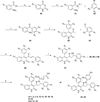Structure-activity relationships and pharmacophore model of a noncompetitive pyrazoline containing class of GluN2C/GluN2D selective antagonists
- PMID: 23909910
- PMCID: PMC4643674
- DOI: 10.1021/jm400652r
Structure-activity relationships and pharmacophore model of a noncompetitive pyrazoline containing class of GluN2C/GluN2D selective antagonists
Abstract
Here we describe the synthesis and structure-activity relationship for a class of pyrazoline-containing dihydroquinolone negative allosteric modulators of the NMDA receptor that show strong subunit selectivity for GluN2C- and GluN2D-containing receptors over GluN2A- and GluN2B-containing receptors. Several members of this class inhibit NMDA receptor responses in the nanomolar range and are more than 50-fold selective over GluN1/GluN2A and GluN1/GluN2B NMDA receptors, as well as AMPA, kainate, GABA, glycine, nicotinic, serotonin, and purinergic receptors. Analysis of the purified enantiomers of one of the more potent and selective compounds shows that the S-enantiomer is both more potent and more selective than the R-enantiomer. The S-enantiomer had an IC50 of 0.17-0.22 μM at GluN2D- and GluN2C-containing receptors, respectively, and showed over 70-fold selectivity over other NMDA receptor subunits. The subunit selectivity of this class of compounds should be useful in defining the role of GluN2C- and GluN2D-containing receptors in specific brain circuits in both physiological and pathophysiological conditions.
Figures







Similar articles
-
Development of a Dihydroquinoline-Pyrazoline GluN2C/2D-Selective Negative Allosteric Modulator of the N-Methyl-d-aspartate Receptor.ACS Chem Neurosci. 2023 Sep 6;14(17):3059-3076. doi: 10.1021/acschemneuro.3c00181. Epub 2023 Aug 11. ACS Chem Neurosci. 2023. PMID: 37566734 Free PMC article.
-
A Novel Negative Allosteric Modulator Selective for GluN2C/2D-Containing NMDA Receptors Inhibits Synaptic Transmission in Hippocampal Interneurons.ACS Chem Neurosci. 2018 Feb 21;9(2):306-319. doi: 10.1021/acschemneuro.7b00329. Epub 2017 Nov 2. ACS Chem Neurosci. 2018. PMID: 29043770 Free PMC article.
-
Distinct GluN1 and GluN2 Structural Determinants for Subunit-Selective Positive Allosteric Modulation of N-Methyl-d-aspartate Receptors.ACS Chem Neurosci. 2021 Jan 6;12(1):79-98. doi: 10.1021/acschemneuro.0c00561. Epub 2020 Dec 16. ACS Chem Neurosci. 2021. PMID: 33326224 Free PMC article.
-
Pharmacological modulation of NMDA receptor activity and the advent of negative and positive allosteric modulators.Neurochem Int. 2012 Sep;61(4):581-92. doi: 10.1016/j.neuint.2012.01.004. Epub 2012 Jan 17. Neurochem Int. 2012. PMID: 22269804 Free PMC article. Review.
-
NMDA Receptor Antagonists: Emerging Insights into Molecular Mechanisms and Clinical Applications in Neurological Disorders.Pharmaceuticals (Basel). 2024 May 15;17(5):639. doi: 10.3390/ph17050639. Pharmaceuticals (Basel). 2024. PMID: 38794209 Free PMC article. Review.
Cited by
-
Functional and pharmacological properties of triheteromeric GluN1/2B/2D NMDA receptors.J Physiol. 2019 Nov;597(22):5495-5514. doi: 10.1113/JP278168. Epub 2019 Nov 2. J Physiol. 2019. PMID: 31541561 Free PMC article.
-
The Role of GluN2C-Containing NMDA Receptors in Ketamine's Psychotogenic Action and in Schizophrenia Models.J Neurosci. 2016 Nov 2;36(44):11151-11157. doi: 10.1523/JNEUROSCI.1203-16.2016. J Neurosci. 2016. PMID: 27807157 Free PMC article.
-
Development of a Dihydroquinoline-Pyrazoline GluN2C/2D-Selective Negative Allosteric Modulator of the N-Methyl-d-aspartate Receptor.ACS Chem Neurosci. 2023 Sep 6;14(17):3059-3076. doi: 10.1021/acschemneuro.3c00181. Epub 2023 Aug 11. ACS Chem Neurosci. 2023. PMID: 37566734 Free PMC article.
-
A structural biology perspective on NMDA receptor pharmacology and function.Curr Opin Struct Biol. 2015 Aug;33:68-75. doi: 10.1016/j.sbi.2015.07.012. Epub 2015 Aug 15. Curr Opin Struct Biol. 2015. PMID: 26282925 Free PMC article. Review.
-
Structural insights into competitive antagonism in NMDA receptors.Neuron. 2014 Jan 22;81(2):366-78. doi: 10.1016/j.neuron.2013.11.033. Neuron. 2014. PMID: 24462099 Free PMC article.
References
-
- Mayer ML. Glutamate receptor ion channels. Curr. Opin. Neurobiol. 2005;15:282–288. - PubMed
-
- Cull-Candy SG, Leszkiewicz DN. Role of Distinct NMDA Receptor Subtypes at Central Synapses. Sci. STKE. 2004;2004:re16. - PubMed
-
- Pérez-Otaño I, Ehlers MD. Homeostatic plasticity and NMDA receptor trafficking. Trends. Neurosci. 2005;28:229–238. - PubMed
Publication types
MeSH terms
Substances
Grants and funding
- T32 GM008602/GM/NIGMS NIH HHS/United States
- R37 NS036654/NS/NINDS NIH HHS/United States
- R37 AI028731/AI/NIAID NIH HHS/United States
- NS071802/NS/NINDS NIH HHS/United States
- R01 AI028731/AI/NIAID NIH HHS/United States
- R01 NS065371/NS/NINDS NIH HHS/United States
- NS065371/NS/NINDS NIH HHS/United States
- F31 NS071802/NS/NINDS NIH HHS/United States
- NS036654/NS/NINDS NIH HHS/United States
- P30 AI050409/AI/NIAID NIH HHS/United States
- R01 NS036654/NS/NINDS NIH HHS/United States
- GM008602/GM/NIGMS NIH HHS/United States
- T32 NS007480/NS/NINDS NIH HHS/United States
- U19 CA087525/CA/NCI NIH HHS/United States
LinkOut - more resources
Full Text Sources
Other Literature Sources
Chemical Information

